Bach - Brandenburg Concerto No. 6 BWV 1051 - I.
José Rodríguez Alvira
In the first movement, a ritornello alternates with developmental sections.
The first viola da braccio presents the thematic material that serves as the ritornello. It begins with two simple motives that emphasise the B flat major key:

The first motive is repeated. However, a new syncopated motive (in blue) follows:

Two notes are added to the motif (in red) ...

... and the new motif begins a downward movement:

They may seem different motives, but the first two share the same notes: F - D - A - B. The last one replaces the A with an F.
So far, we have only heard the notes of the B-flat major chord, with a few A notes used as nonharmonic tones.
Descending sixteenth notes follow a new variant of the motive:

The first bars are repeated on the V degree (F major, dominant of B flat major). Although the theme uses an E natural, the harmony is that of an F dominant chord because of the E-flat that appears in the accompaniment. Bach ends the passage with descending arpeggios:
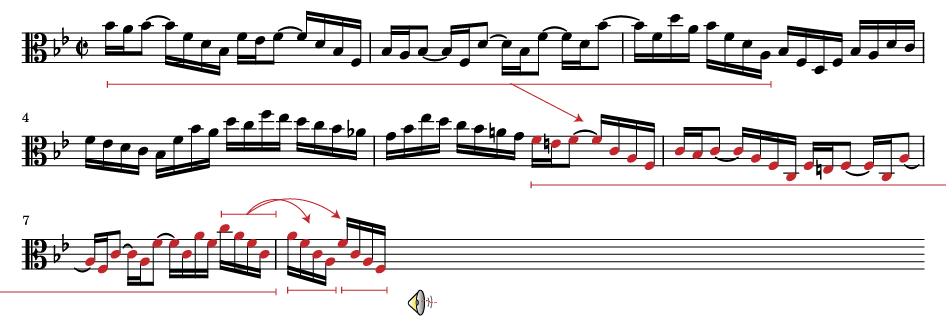
We return to the ascending and syncopated motive of the second measure. It is followed by the descending sixteenth notes of bar 4.
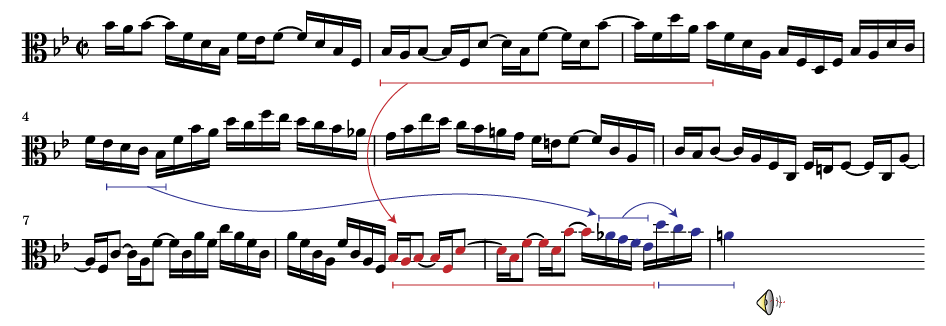
Bach reuses the rhythmic motive of the first two beats, varying the melodic movement ...
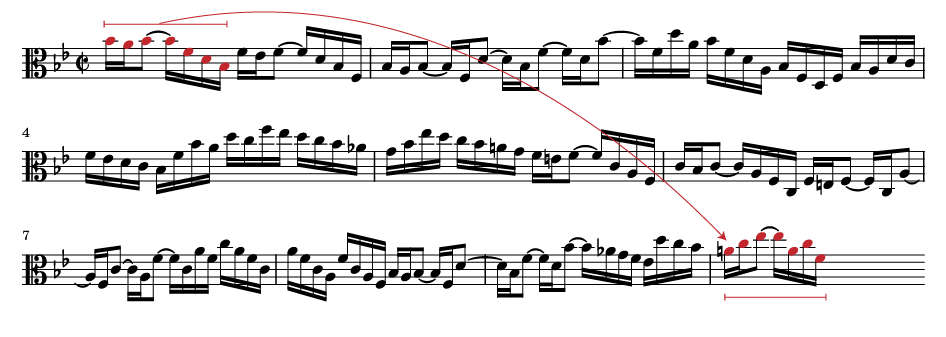
... repeating it and adding some ascending arpeggios (in blue):
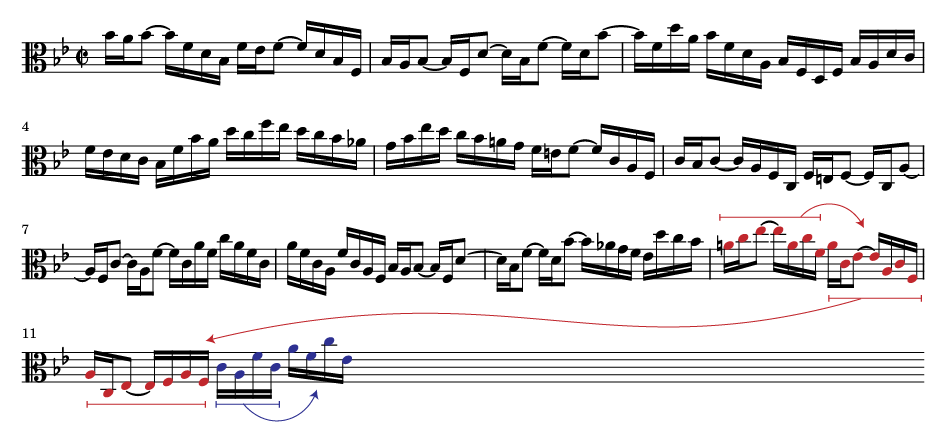
Bach repeats bars 10 and 11. In the second repetition (bar 15), he uses only the first notes and repeats the thematic material of bars 2 and 3 (in blue) to conclude the theme:
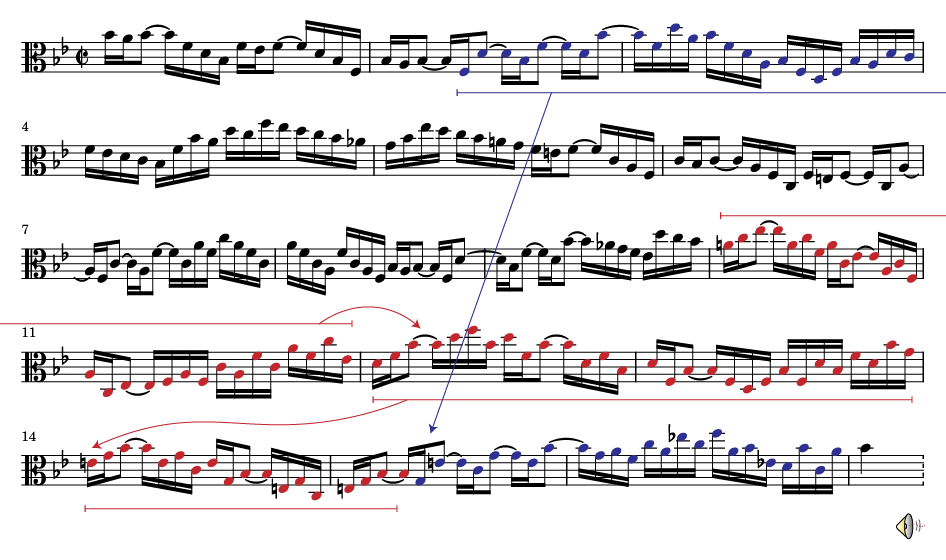
- The theme presented by the first viola is imitated by the second viola in canonical form, one octave apart. We have marked the imitations with red lines.
- We have marked in blue brief interruptions of the imitations in bars 8, 9, 11, 12, 12, 15 and 16.
- The violas da gamba, cellos and continuo establish the harmony with repeated eighth notes.
- We find a dominant pedal (F) from bar 10 to 16.
Douglas Boyd (conductor), Gardner Chamber Orchestra (ensemble)
Creative Commons Attribution Non-commercial No Derivatives 3.0
In canonical form, the instruments develop the first motive of the theme:
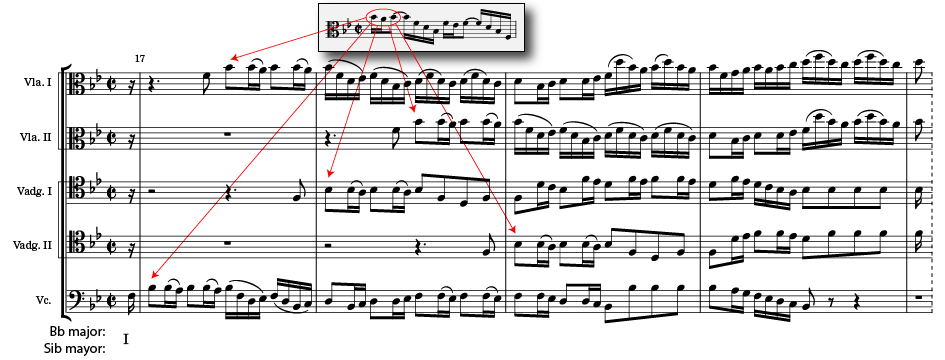
- The cello (1) begins and is imitated by the first viola da braccio (2), which expands the thematic material.
- The first viola da gamba (3) follows, simplifying the sixteenth note arpeggios.
- The second viola da braccio (4) imitates the first viola da braccio.
- The second viola da gamba (5) imitates the first viola da gamba.
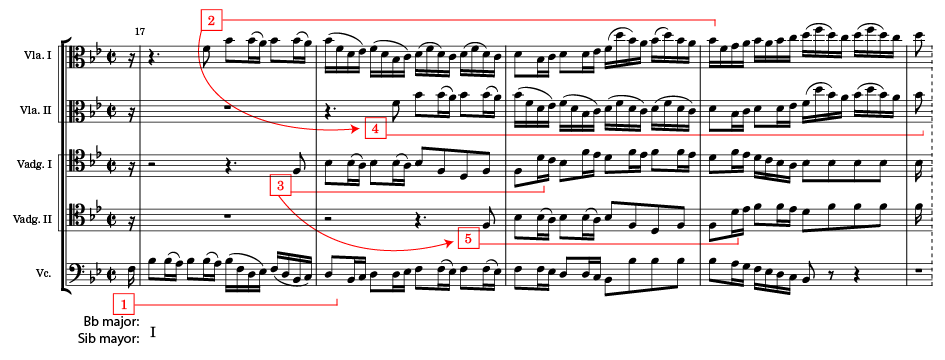
- From bar 21, the violas da braccio develop a motive taken from the fourth bar of the theme.
- The second viola imitates the first at the seventh (F of the first becomes G of the second) with some liberties.
- The violas da gamba accompany with the first motive of the theme.
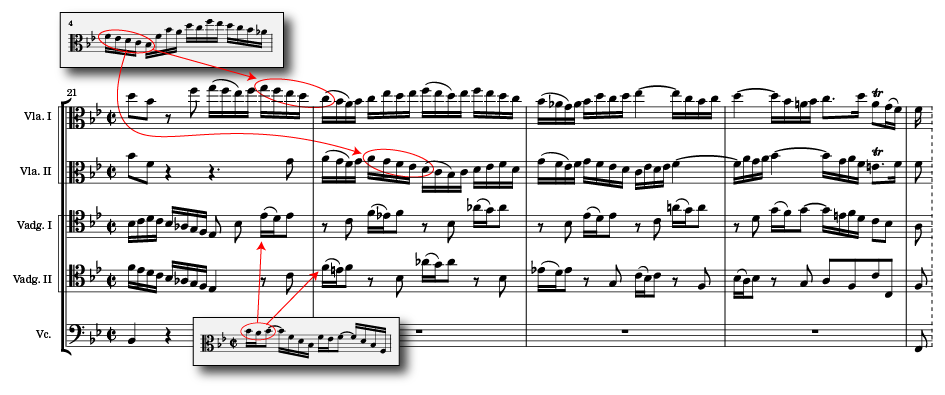
The passage leads us to F major:
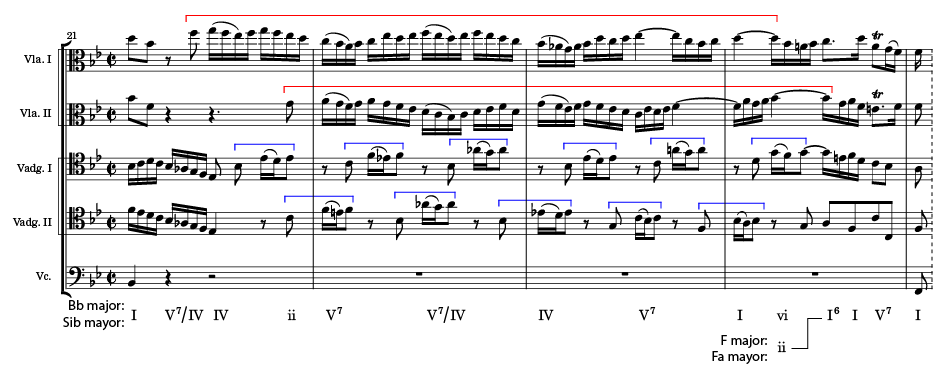
These two patterns of development, will be repeated throughout the movement. D1 based on the initial motive and D2 on the descending melodic movement of bar 4:
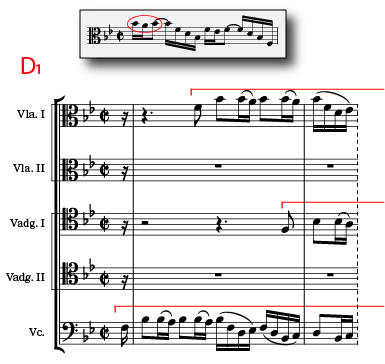
D1 is characterised by:
- The use of the initial motive of the theme for the construction of a canon at the octave.
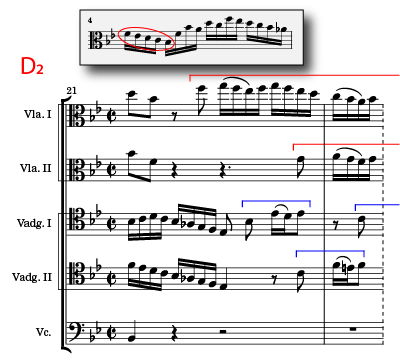
D2 is characterised by:
- Motive of the fourth bar in the violas de braccio in a canon at the seventh.
- Initial motif of the theme in the violas da gamba.
First development, measures 17 to 25:
D1 development pattern
D2 development pattern
Douglas Boyd (conductor), Gardner Chamber Orchestra (ensemble)
Creative Commons Attribution Non-commercial No Derivatives 3.0
The ritornello reappears, reduced to three bars, in F major (the dominant). Surprisingly, the dominant Eb chord in bar 27 functions as Bb major IV (see box below).
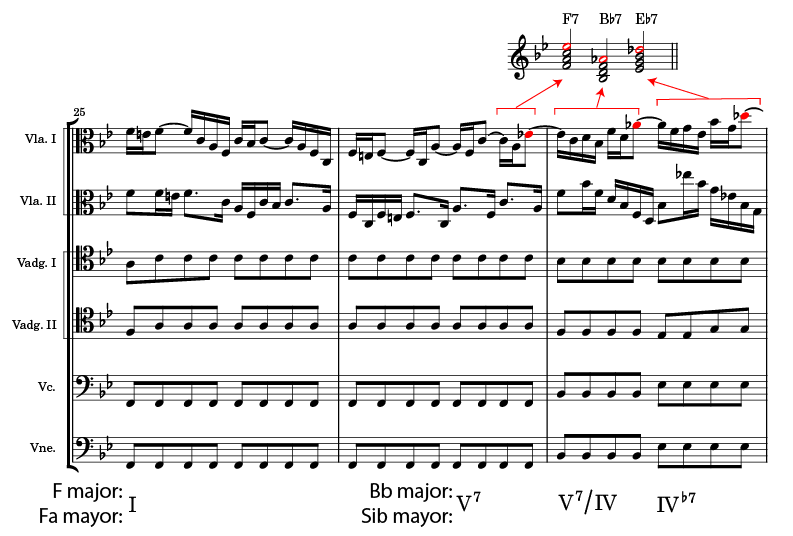
Eb is the V degree of Ab, a chord that does not exist in Bb major. The Eb dominant chord is used as a Bb major IV degree chord. Bb7, Eb7 and F7 are the typical Blues chords in the key of Bb major.
Listen to the ritornello. Note the sevenths played by the first viola da braccio (Eb in bar 27 and Ab and Db in bar 28):
Douglas Boyd (conductor), Gardner Chamber Orchestra (ensemble)
Creative Commons Attribution Non-commercial No Derivatives 3.0
- The second development begins with the development pattern D1, similar to bar 17.
- The first viola da braccio is imitated by the second (3).
- The cello intersperses short presentations of the first motive (2 and 4).
- In bar 31, the cello presents a variant of the first motive (original motive marked in blue neumes) and is imitated by the viola da braccio. This motive had already appeared in bar 29.
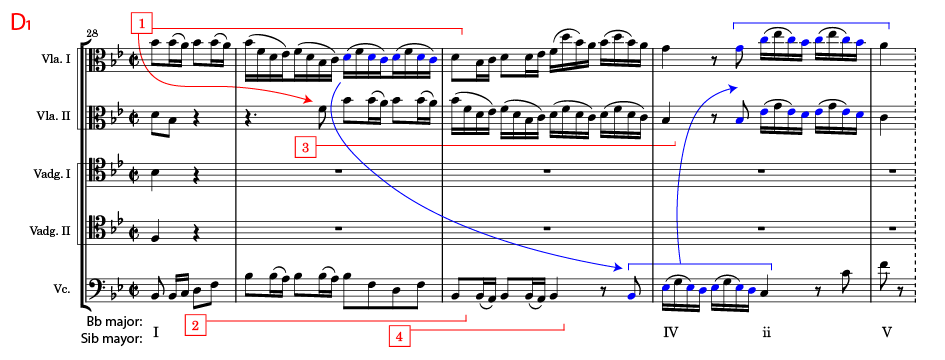
- A new canon based on the first motive of the theme with the participation of all instruments.
- We modulate to F major.
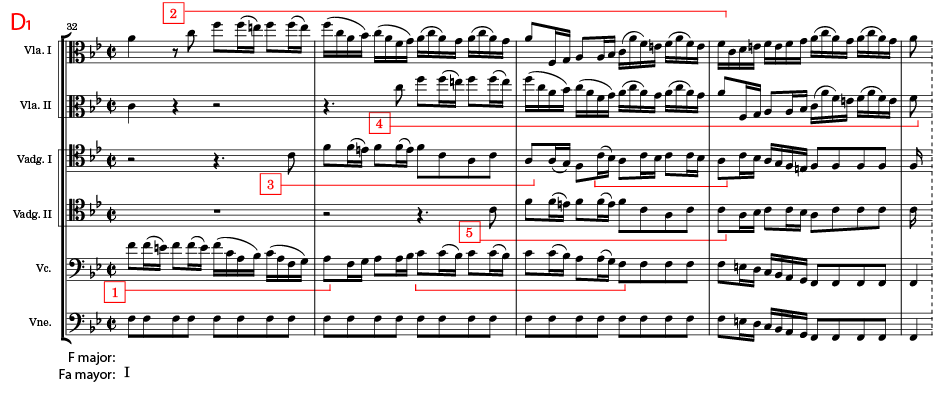
- Now we move on to the development pattern D2.
- The violas da braccio develop the motive of bar 4, while the other violas use the motive of the first bar.
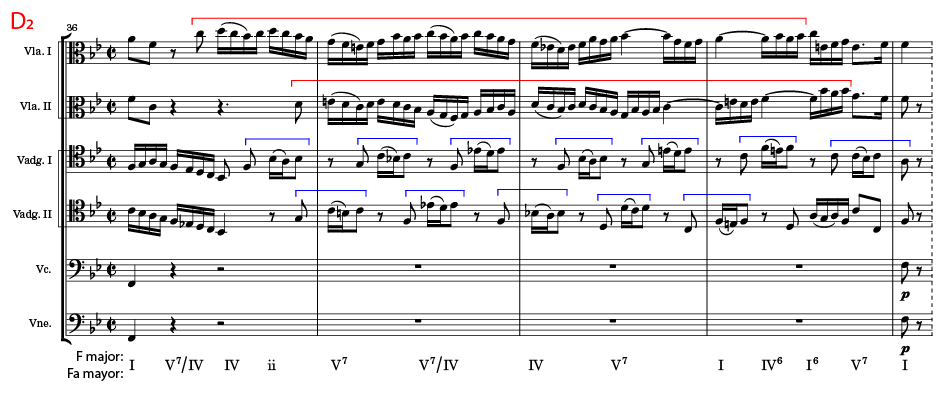
- The first viola da braccio melodically develops the first motive of the theme.
- The other instruments accompany with repeated eighth notes.
- A harmonic sequence leads from F major to G minor and C minor.
- Each step of the sequence begins with the first motive of the theme in the second viola da braccio and the other violas.
- We will identify this development pattern as D3.

Second development, measures 28 to 46
D1 development pattern
D2 development pattern
D3 development pattern
Douglas Boyd (conductor), Gardner Chamber Orchestra (ensemble)
Creative Commons Attribution Non-commercial No Derivatives 3.0
The C minor ritornello is seven bars long. Its first notes - marked in blue - are varied:
Douglas Boyd (conductor), Gardner Chamber Orchestra (ensemble)
Creative Commons Attribution Non-commercial No Derivatives 3.0
- We immediately move from C minor to F major using the D3 development pattern.
- In bar 55, we modulate to D minor.
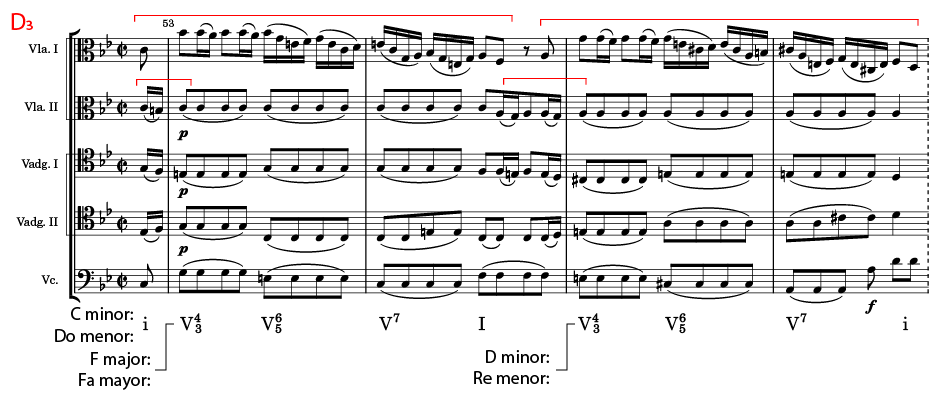
Measure 56 - the D1 pattern of development is used:
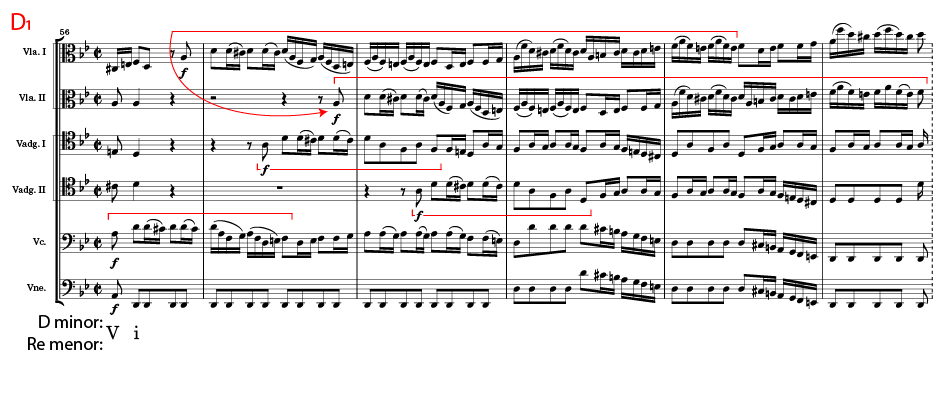
Measure 62 - development pattern D2 leads to G minor:
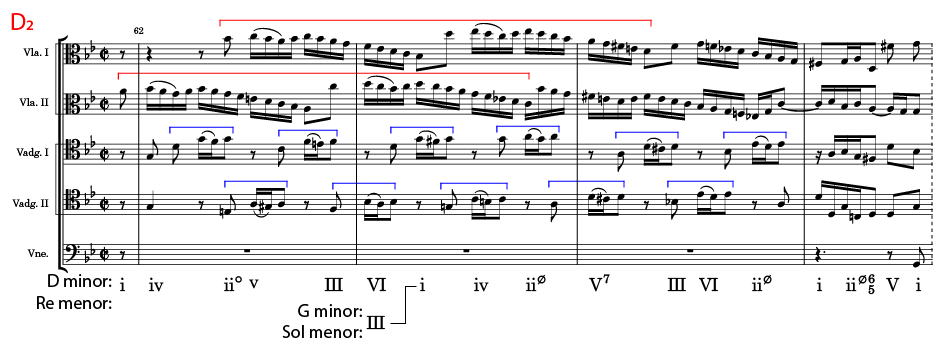
Measure 65 - the viola da gamba accompanies the D1 development pattern with repeated eighth notes:
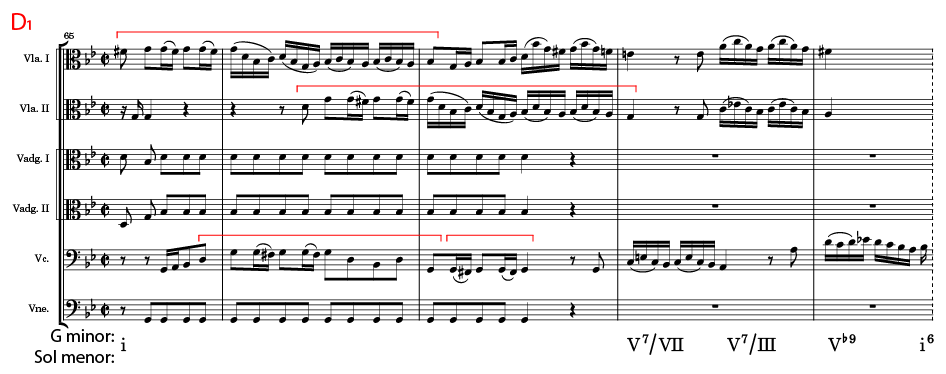
Measure 69 - the development pattern D2 confirms the key of G minor:

Third development, measures 53 to 73:
Development pattern D3
Development pattern D1
Development pattern D2
Douglas Boyd (conductor), Gardner Chamber Orchestra (ensemble)
Creative Commons Attribution Non-commercial No Derivatives 3.0
The ritornello in G minor is seven bars long:
Douglas Boyd (conductor), Gardner Chamber Orchestra (ensemble)
Creative Commons Attribution Non-commercial No Derivatives 3.0
This is the shortest development with only 7 bars.
- We start with a variation of the D1 development. It uses a motif from the end of this pattern.
- The cello dialogues with the violas and takes us from G minor to Bb major.
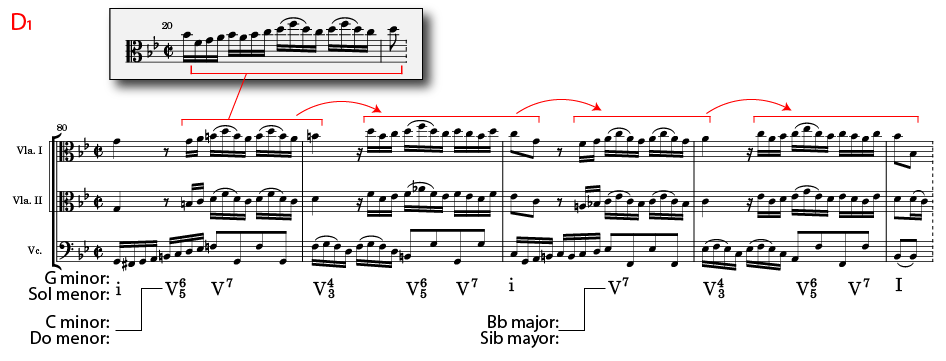
Two bars of the development D3 conclude with a modulation to Eb major:
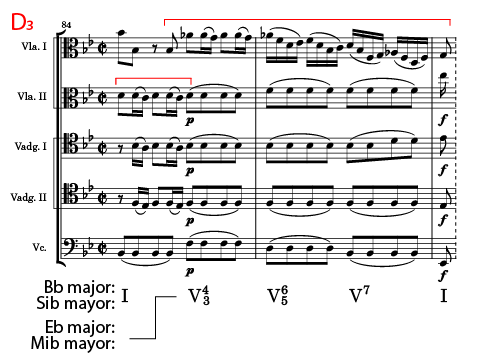
Fourth development, measures 80 to 86
Variant of developmental pattern D1 using the final motif
Development pattern D3.
Douglas Boyd (conductor), Gardner Chamber Orchestra (ensemble)
Creative Commons Attribution Non-commercial No Derivatives 3.0
In the ritornello in Eb major, the second viola begins the canon and is imitated by the first viola. From bar 89, the roles are reversed:
Douglas Boyd (conductor), Gardner Chamber Orchestra (ensemble)
Creative Commons Attribution Non-commercial No Derivatives 3.0
- The final development begins with a variant of the D3 pattern. The theme is developed in canonic form.
- The second viola imitates the first viola.
- The violas da gamba use the first bar motive.
- From Eb major we move to F major.
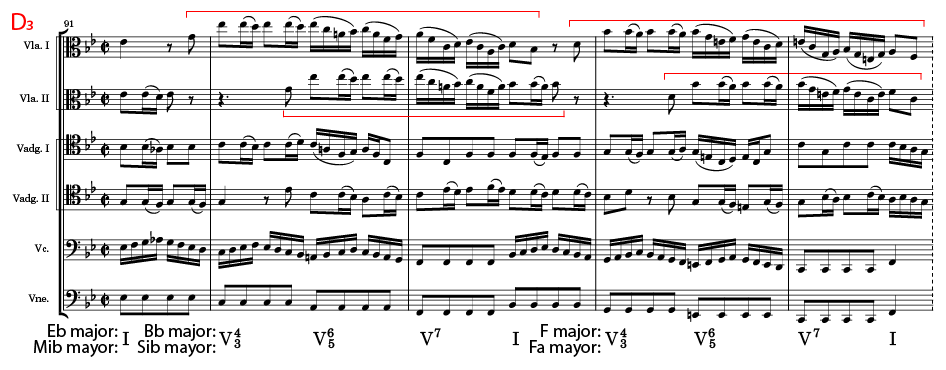
- Development pattern D2 begins at bar 96.
- The voices of the canon are inverted, the canon at the seventh becomes a canon at the second.
- The violas da gamba insist on the motive of the first bar.
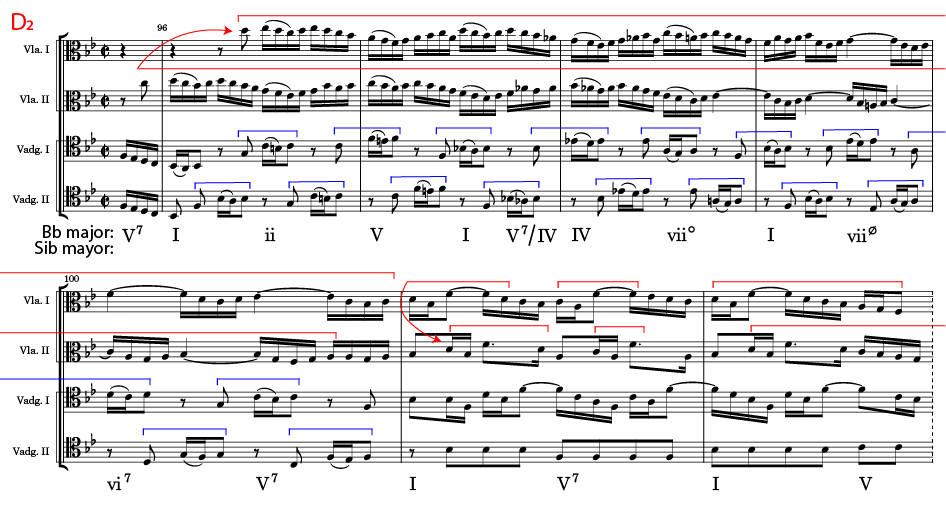
Development pattern D1 from bar 102:
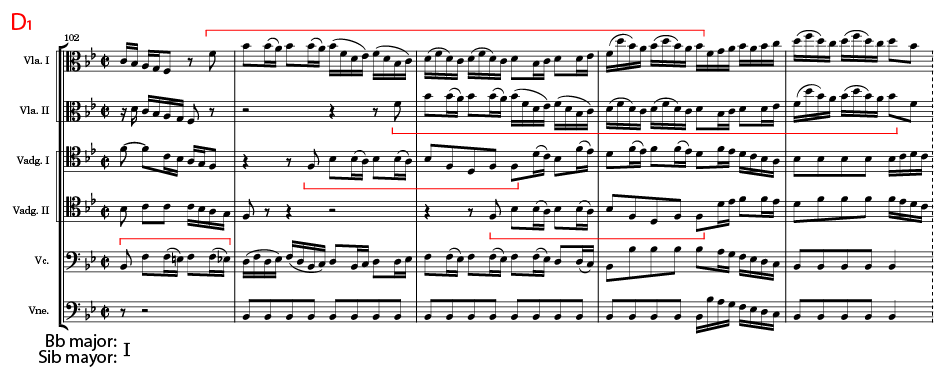
We end with pattern D2:
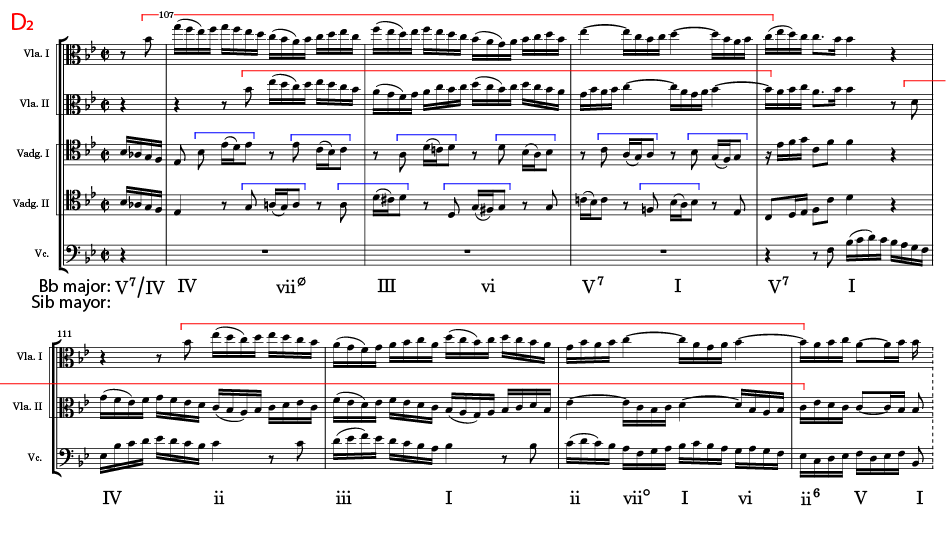
Fifth development, measures 91 to 114:
Development pattern D3
Development pattern D2
Development pattern D1
Douglas Boyd (conductor), Gardner Chamber Orchestra (ensemble)
Creative Commons Attribution Non-commercial No Derivatives 3.0
The final ritornello is an exact repetition of the first:
Douglas Boyd (conductor), Gardner Chamber Orchestra (ensemble)
Creative Commons Attribution Non-commercial No Derivatives 3.0
Ritornello in Bb major
First development, pattern D1
First development, pattern D2
Ritornello in F major
Second development, pattern D1
Second development, pattern D2
Second development, pattern D3
Ritornello in C minor
Third development, pattern D3
Third development, pattern D1
Third development, pattern D2
Ritornello in G minor
Fourth development, pattern D1 variation
Fourth development, pattern D3
Ritornello in Eb major
Fifth development, pattern D3
Fifth development, pattern D2
Fifth development, pattern D1
Douglas Boyd (conductor), Gardner Chamber Orchestra (ensemble)
Creative Commons Attribution Non-commercial No Derivatives 3.0

This work is licensed under a Creative Commons Attribution-NonCommercial-NoDerivatives 4.0 International License. José Rodríguez Alvira.
Published by teoria.com


